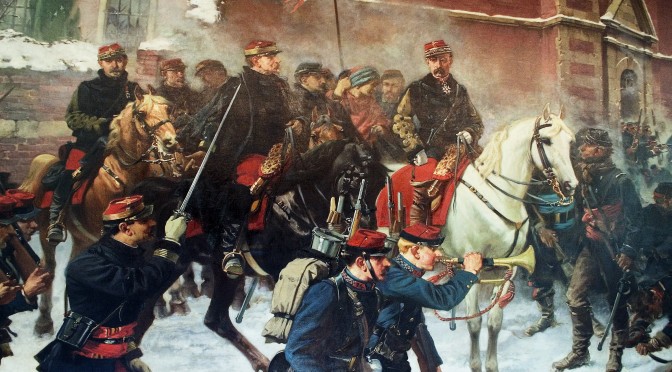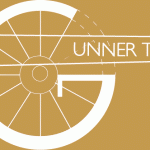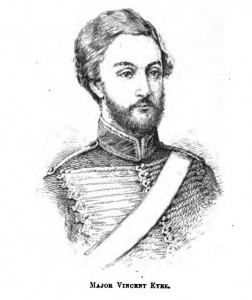 When war broke out between France and the German states in August 1870 , the 59 year old retired Major General Sir Vincent Eyre KCSI, CB happened to be in France. This was the first war to take place in North West Europe since Waterloo over half a century earlier. Since Waterloo much had changed. Telegraphs and newspapers brought home to the public the suffering of the wounded. Florence Nightingale had revolutionised nursing. The Geneva Convention of 1864 had provided for the neutrality of the medical personnel of armed forces, the humane treatment of the wounded, the neutrality of civilians who voluntarily assisted them and the Red Cross Society.
When war broke out between France and the German states in August 1870 , the 59 year old retired Major General Sir Vincent Eyre KCSI, CB happened to be in France. This was the first war to take place in North West Europe since Waterloo over half a century earlier. Since Waterloo much had changed. Telegraphs and newspapers brought home to the public the suffering of the wounded. Florence Nightingale had revolutionised nursing. The Geneva Convention of 1864 had provided for the neutrality of the medical personnel of armed forces, the humane treatment of the wounded, the neutrality of civilians who voluntarily assisted them and the Red Cross Society.
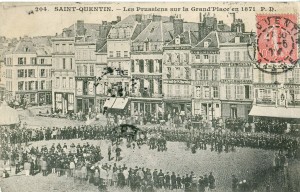
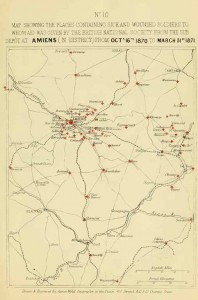
Sir Vincent Eyre and Lady Eyre, in the name of the English Red Cross Society formed a committee in Bolougne and raised a British volunteer ambulance service. It provided hospitals, field ambulances medical staff and vehicles to collect and treat the wounded on battlefields across Northern France including many places familiar to the soldiers of the Great War such as Amiens Villers-Brettonoux, Bapaume, Peronne and St Quentin, the Somme battlefields of 1870-1871. These were led by British military officer and nurses trained by Florence Nightingale. The British brought their Indian experience and some staff including the Pharsee wife of the surgeon at St Quentin. including some By their medical services were treating 15,000- 20,000 patients a month.(1) Eyre’s report is in The report on the operations of the British National Society for air to the Sick and Wounded in War.
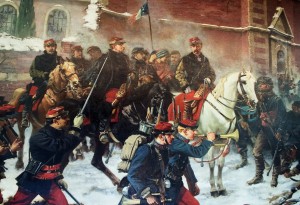
Vincent Eyre was born in 1811, in then Napoleonic era, four years before Waterloo. The son of a captain and educated at Norwich Grammar School. Eyre entered the Military Academy at Addiscombe when about fifteen, and passed out into the artillery of the company on 12 Dec. 1828. He was gazetted to the Bengal establishment, and landed in Calcutta 21 May 1829. After eight years he was promoted to be first lieutenant, and appointed to the horse artillery of the Company.
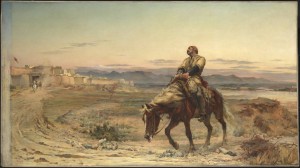
In 1839 Eyre was appointed commissary of ordnance to the Kabul field force and present during the 1841 rising. Eyre was in command of two guns sent out with a sally from Kabul and severely wounded. During the retreat from Kabul Eyre, still suffering from his wound, and his wife and child were surrendered as hostages. They were lucky. The dozen or so hostages were the only survivors out of some 4,500 soldiers and 12,000 civilians in retreat the column that withdrew from Kabul, and freed from being sold as slaves to the Uzbeks by a dramatic rescue.
Fifteen years later, in July 1857 Major Eyre was moving his company of the Bengal Artillery from Calcutta up into Oudh. Being the wet season of the year, when the river level was high, the gunners and their guns were usually conveyed up the river Ganges by river steamer, while the drivers and horses marched by road. While en route, Eyre heard that three Native Infantry regiments had mutinied and had attacked and besieged the civilian population at the small town of Arrah. (Now Ara)
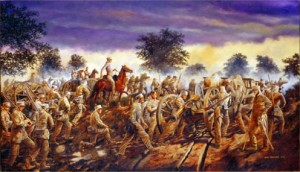
Eyre disembarked his men and guns, collected a party of HM’s 5th Fusiliers and set off for Arrah. His own horses not having arrived, he commandeered local bullocks to draw his two 9-pounder guns and one 24-pounder howitzer. His ammunition was carried in country carts. After a march of over 40 miles, he encountered an enemy force of more than 10,000 trained soldiers barring his way at Bibigunge. On the morning of 2nd August he immediately led his small body of around 225 troops into the attack, carefully supported by the fire of his guns. Two attempts by the mutineers to rush the guns were broken with salvoes of case shot. After an hour’s fighting, the skirmishers of the 5th Fusiliers turned the enemy’s right flank. The gunners poured case and shrapnel into their front, and a bayonet charge by the Fusiliers won the day. This battle raised the siege of Arrah. Eyre’s exploits were recognised by the award of the battery honour title of 58th (Eyres) Battery Royal Artillery.
Fyre played a distinguished part in the relief of Lucknow and quelling the Indian Mutiny. After the rebellion he was promoted to Colonel and retired in ill health as a Major General in 1863. His first wife died in 1851 and in 1860 he married his cousin.
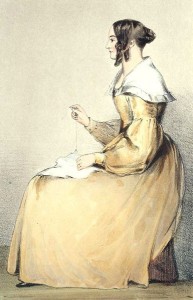
Eyre was a talented artist. Whilst in captivity he made sketches of the captives which were smuggled out of Afghanistan and published. You can see some of the images here.
The 1870-71 Campaign in Picardy was the Sir Vincent Eyre’s last campaign. In 18180 he contracted a spinal disease and died the following year in Southern France. On 2nd August every year 58 (Eyres) Battery Royal Artillery remember Eyre and commemorate the relief of Arrah on their battery day. http://www.theraa.co.uk/history/battery-days
If you want to visit the sites of the 1870-71 battles or associated with the Royal Artillery contact Gunner Tours
Notes
1. RUSI Journal: Lecture by Surgeon Major F J Mouet, A visit to the Battlefields and Ambulances of Northern France Friday 21st April 1871
